Our next stop was up North across the border into County Durham, as we arrived in the railway town of Darlington…
Darlington:
Status: Darlington Unitary Authority, County Durham, Town, England
Date: 01/10/2015
Travel: Car
Eating & Sleeping: N/A
Attractions: Darlington Market Hall, Clock Tower, St Cuthbert’s Church, Darlington Railway Station, River Skerne, Joseph Pease Statue, King’s Head Hotel etc
I have been wanting to visit Darlington for some time, ever since I first saw a picture of the towns historic Victorian Covered Market, with its famous Clock Tower.
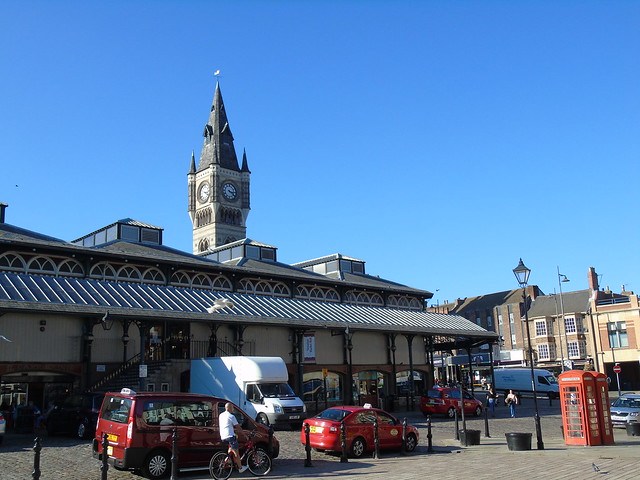
Luckily, as we arrived the first place I found to park was in the Market Square itself, right at the base of the Market Hall. I wasn’t disappointed, and even the pictures don’t do this magnificent building justice.
The Market dates from 1864, paid for by Joseph Pease (1799 – 1872, MP for South Durham in the 1830’s). He also provided funds for the Towns first Town Hall, although it was replaced in the 1970’s with a new brutalist building off the other end of the Market Square.
When we visited, there was a line of Red Taxi’s outside, along with the typical Red Phone Boxes, which together gave the whole scene a very British feel.
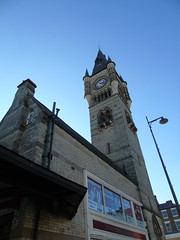
The Market’s Clock Tower is perhaps the finest outside of London, and stands a magnificent 138 ft tall, visible from most areas of the Town Centre.
The bells which hang in the tower were created by T. Cooke & Sons from York, who also produced those which hang inside Big Ben in London, effectively making them the sister bells of Darlington’s.
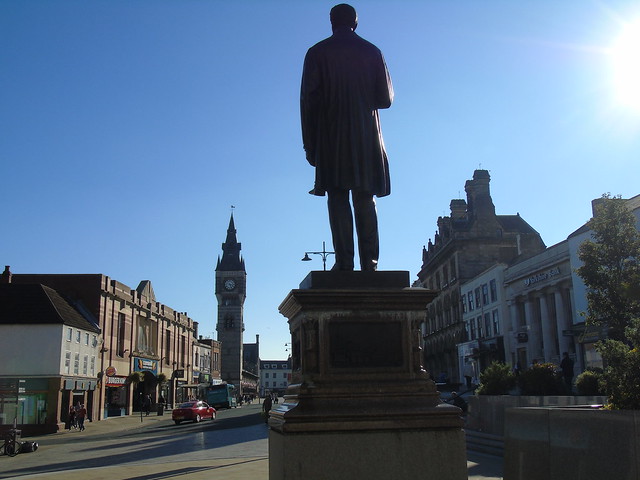
Darlington is a very photogenic town, and we took a walk up the main shopping street, called “High Row”, which also runs past the large Cornmill Shopping Centre, shown on the left.
At the far end of High Row is a nice little group of historic buildings, along with a large statue of the aforementioned Joseph Pease, gazing back at his most outstanding contribution to the town, the Clock Tower in the distance.

Joseph created a slight controversy upon his election as MP for South Durham in 1832. As he was a Quaker, he refused to take the Oath and swear by God allegiance to the Queen as all MP’s must.
It was later decided to make a special exception for him, whereby because of his status he could take a “Solemn Affirmation” instead of the Oath, which removes the requirement to swear in the name of God.
Joseph is literally larger than life, as the large Zinc/Copper statue created by George Anderson Lawson in 1875 is 1.5 x larger than life size.
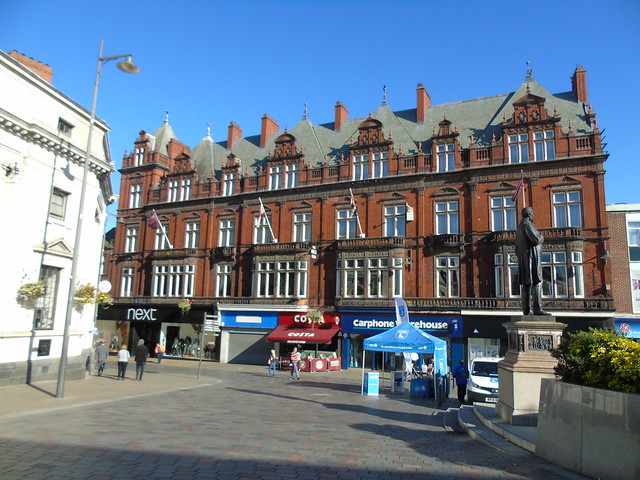
On Mr Pease’s left, sits the splendid Victorian facade of the “King’s Head Hotel”, which is slightly unusual as the whole hotel is suspended above the shops at street level.
The Hotel was recently restored in all its glory, reopening in 2012 after a devastating fire that severely damaged it.
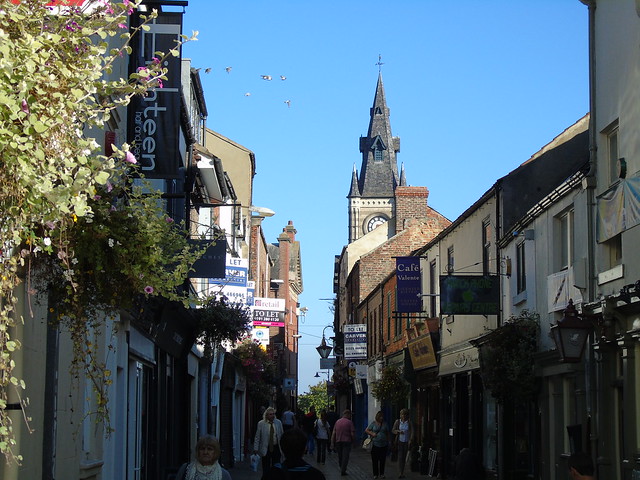
As I said earlier, the Clock Tower is visible from pretty much every vantage point. I took this photo from an alleyway lined with shops, connecting Skinnergate (which runs behind High Row) back to High Row itself.
The Tower cut an impressive figure above the various Georgian/Victorian shops, and giving this little street a very historic feel.
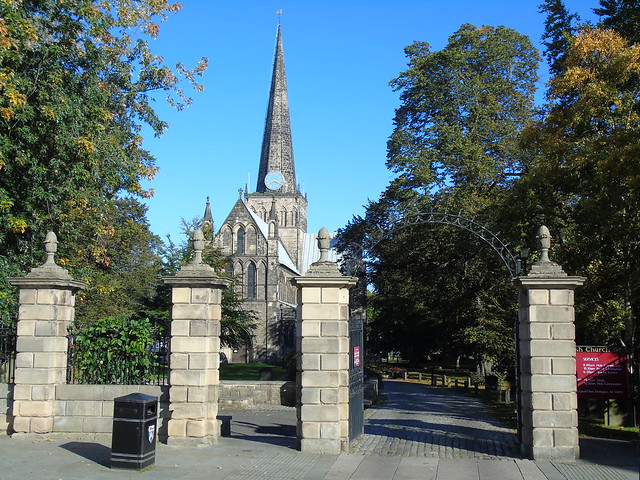
The Market Square is bounded by the Market Hall/Clock Tower to the West, and to the East by the Church of St Cuthbert’s.
Entry to the Churchyard is gained through a large set of early 19th century iron gates, inter-spliced between the grand Ashlar columns which support them.
Construction of St Cuthbert’s began in 1180, taking roughly 60 years. At the time it would have been slightly smaller in scale. The large Tower/Spire with the Transept Crossings was only added the following century, and the Nave was altered/extended in 1975. There have been no burials in the Churchyard since 1856, when it was closed after presumably becoming too full.
The Church was founded by Bishop Hugh de Puiset (1125 – 1195, Bishop of Durham), who also built a Bishop’s Palace nearby in 1164. Sadly this no longer exists, as it was demolished in the 1970’s to make way for the new Borough Council Offices.
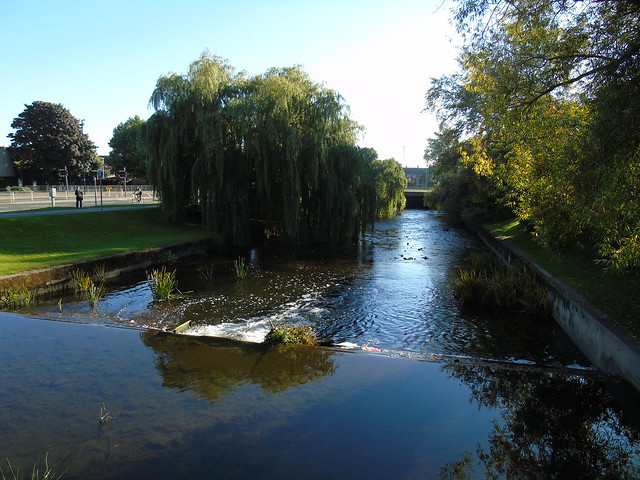
Moving past the Church, down the side of the Town Hall towards the ring road which encircles the town centre, we reached the River Skerne, a short, 25 mile long waterway that eventually empties out into the River Tees just across the border into North Yorkshire
There are a small series of weirs on the section here in Darlington, and this whole stretch of river was quite recently restored, with the addition of new footpaths and foliage.

Darlington might be famous for its Market Place Clock Tower, but it isn’t the only Clock to grace the skyline. Following the ring road round Clockwise, we ended up at the start of “Victoria Road”, which leads up to the imposing entrance to Darlington Railway Station.
Darlington is quite well known for its railway history, as in 1825, the worlds first steam engine operated public railway opened between the Shildon Collieries, and Stockton-on-Tees/Darlington. Railways quickly spread across the area, including to the busy port at Middlesbrough further up the River Tees. By 1830, the mainline from Liverpool to Manchester had opened, becoming the worlds first intercity railway.
The original station at Darlington was called Bank Top, and by 1844 it was in use by two separate routes, the original from Shildon which was extended South to York, and a new Branch North to Newcastle. The two ended up crossing using a flat crossing, which was a potential bottleneck on the system.
This resulted in the station we see today, which was built to incorporate all of the railway routes together, including new ones which eventually branched off towards Penrith and Barnard Castle. Designed by William Bell, it opened in 1887 and has ever since been an important stop on the East Coast Main Line between London and Edinburgh. All trains following this route stop at Darlington, giving it good links both North and South. A number of Cross County trains also stop here, which continue down to Birmingham and then Devon/Cornwall.
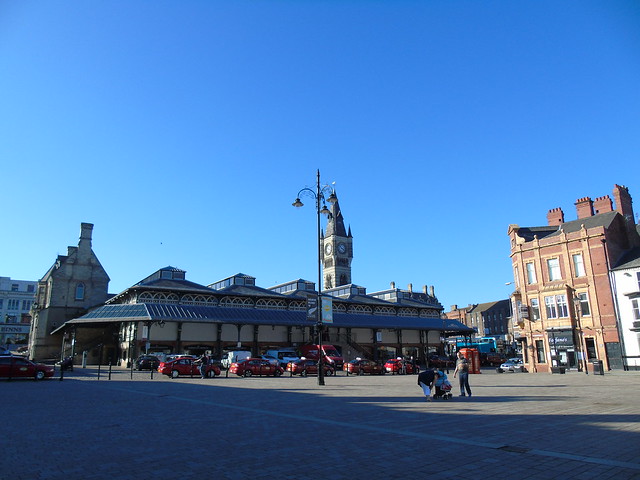
We finished our walk back in the Market Square, once more gazing up at the Market Hall in front of us. The whole town centre is just a nice pleasant place to be, with a town which prospered with the arrival of the railways, to become the largest settlement in the North East after only Newcastle, Sunderland and Middlesbrough.
This is reflected in the fact that Darlington became a Unitary Authority area separate from Durham County Council in 1997. Darlington accounts for around a fifth of the total population of County Durham as a whole.
Darlington is also well placed on the road network, as the A1/A1 (M) runs directly past the town bound for Newcastle in the North, and York/London in the South. Also nearby is the famous Scotch Corner junction with the A66 which heads West towards the M6, Cumbria and Carlisle.
Darlington is a lovely little town, and now sits proudly on our travel map, another well spent day exploring!
